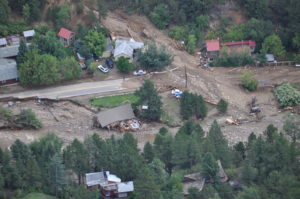Landslides
 Landslides, also known as mudslides and debris flow, occur in all U.S. states and territories and can be caused by a variety of factors including earthquakes, storms and fires. They can occur quickly, often with little notice and develop when water rapidly accumulates in the ground, during heavy rainfall or rapid snow melt, changing the earth into a flowing river of mud or “slurry.”
Landslides, also known as mudslides and debris flow, occur in all U.S. states and territories and can be caused by a variety of factors including earthquakes, storms and fires. They can occur quickly, often with little notice and develop when water rapidly accumulates in the ground, during heavy rainfall or rapid snow melt, changing the earth into a flowing river of mud or “slurry.”
Before a landslide:
- If you suspect imminent danger, evacuate immediately. Inform affected neighbors if you can, and contact your public works, fire or police department.
- Learn about your area’s landslide risk. Watch the patterns of storm water drainage on slopes near your home, especially where runoff water converges.
- Landslides generally happen in areas where they have occurred in the past.
During a landslide:
- Move away from the path of a landslide or debris flow as quickly as possible.
- Mudflows can move faster than you can walk or run.
- The danger from a mudflow increases near stream channels and with prolonged heavy rains.
- Look upstream before crossing a bridge and do not cross the bridge if a mudflow is approaching.
- Curl into a tight ball and protect your head if escape is not possible.
- Be especially alert when driving— watch for collapsed pavement, mud, fallen rocks and other indications of possible debris flow.
After a landslide:
- Be aware that, generally, landslide insurance is not available, but that debris flow damage may be covered by flood insurance policies from the National Flood Insurance Program (NFIP).
